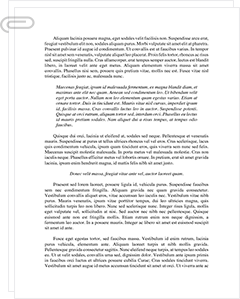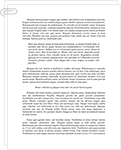 Study Document
Study Document
Fake News and How to Stop It Essay
Pages:2 (611 words)
Sources:2
Subject:Technology
Topic:Social Media
Document Type:Essay
Document:#43392270
Research Question: Why is “fake news” so hard to identify and what can be done to limit its influence in society?
After considering the information in this week’s instructor guidance and readings, I understand ethos to refer to the credibility of the author, pathos to refer to the emotional substance of the argument, and logos to refer to evidence and logic.
Revised Thesis Statement:
• Internet technologies enable the proliferation of fake news, and only education and awareness can curtail the influence fake news has on society.
Claim #1:
• Prior exposure to the fake news item makes a person more likely to believe that the story is true (Pennycook, Cannon, & Rand, 2017).
Claim #2:
• Mob mentality is at work with fake news, as research shows a viral post is more likely to be perceived as trustworthy even when it is fake (Papanastasiou, 2017).
Counterargument & Rebuttal
• It is too difficult to debunk fake news because the algorithms used in social media sites make it almost impossible to prevent content from going viral (Pennycock & Rand, 2017).
• Just because it is difficult, educating the public about how to detect fake news is still important for a fully functioning democracy.
I developed these claims based on the research I conducted on fake news.
I revised my thesis statement based on the complexity of the argument.
After reading the course materials, I have questions about how to construct an effective counter-claim.
References
“English 122: Composition II An Introduction to Argument,” (n.d.). Ashford University.
Papanastasiou, Y. (2017). Fake news propagation and detection. https://papers.ssrn.com/sol3/papers.cfm?abstract_id=3028354
Pennycook, G., Cannon, T.G. & Rand, D.G. (2017). Implausibility and illusory truth. https://papers.ssrn.com/sol3/papers.cfm?abstract_id=2958246
Pennycook, G. & Rand, D.G. (2017). The implied truth effect. https://papers.ssrn.com/sol3/papers.cfm?abstract_id=3035384
(Rough Draft of a Body Paragraph)
People believe fake news not because they are ignorant or stupid, but because of the way the brain works. Research consistently shows that people favor content that has already gained widespread approval, much in the same way propaganda works. For example, Pennycock & Rand (2017) show that even when a news item has been flagged as being fake, it is still perceived of as real. Confirmation bias is also at play with fake news, as prior exposure to the fake news item makes a person more likely…
Sample Source(s) Used
References
Papanastasiou, Y. (2017). Fake news propagation and detection. https://papers.ssrn.com/sol3/papers.cfm?abstract_id=3028354
Pennycook, G., Cannon, T.G. & Rand, D.G. (2017). Implausibility and illusory truth. https://papers.ssrn.com/sol3/papers.cfm?abstract_id=2958246
Pennycook, G. & Rand, D.G. (2017). The implied truth effect. https://papers.ssrn.com/sol3/papers.cfm?abstract_id=3035384
Verma, N., Fleischmann, K.R. & Koltai, K.S. (2017). Human values and trust in scientific journals, the mainstream media, and fake news. 80th Annual Meeting of the Association for Information Science & Technology, Washington, DC, VA | Oct. 27-Nov. 1, 2017
Related Documents
 Study Document
Study Document
Fake News Essay
I. Abstract II. Introduction III. Review and Discussion A. What is fake news? B. The potential impact of fake
 Study Document
Study Document
Fake News and Knowledge is Power
With the election of Donald Trump, it seems that power might come from the absence of knowledge. As Barton points out, fake news was once a fringe effect but has now become a "a strategy for consolidating executive power," (1). Anti-intellectualism and the dumbing down of American, which Richard Hofstadter describes in his 1964 Pulitzer Prize-winning book Anti-Intellectualism in American Life, highlights the problem of when
 Study Document
Study Document
Fake News Outline
THE ALLURE OF FAKE NEWS: Outline
I. Introduction
A. Thesis statement: Internet technologies enable the proliferation of fake news, and only education and awareness can curtail the influence fake news has on society.
II. Body Paragraph
A. Claim: Prior exposure to a fake news story makes a person more likely to believe in the veracity of the information.
1. Evidence: Just a one-time exposure to a fake news item on
 Study Document
Study Document
Fake News Detection
Fake News Detection
Introduction
How can fake news be detected and prevented from dominating the online discourse of news events? Numerous researchers have been discussing this issue and identifying ways to detect fake news, whether on social media (Shu et al.) or by creating a benchmark dataset to facilitate the process (Wang). The topic of this study is fake news detection and what methods are available in this new field.
 Study Document
Study Document
Fake News
Fake News
One of Donald Trump’s common terms or catch phrases when he rants and raves on social media would happen to be “fake news”. This pejorative is commonly aimed at news outlets like CNN and other media outlets that cover him, fairly or not. CNN et al commonly recoils and reacts to that term in very negative and reflexive ways. There is some truth to what Trump says about
 Study Document
Study Document
Fake News
The Real from the Fake
Fake news is a phenomenon that arguably arose during the present decade. It has become a catchword, a battle cry, or perhaps just the repeated punch line of jokes. In that sense, it is similar to the world ‘selfie’ a few years ago. Nonetheless, fake news is more important than photographs and paraphernalia designed to promote the taking of photographs of one’s self. It has



